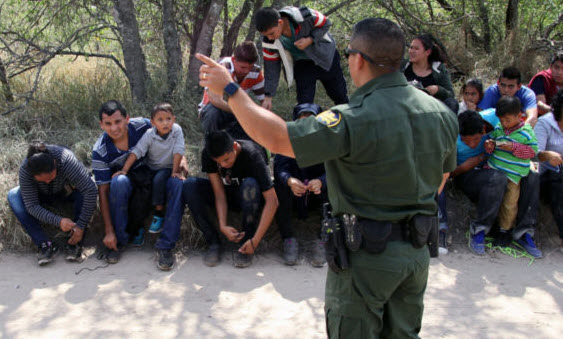
Buried in the appendix of a recent report from the Government Accountability Office (GAO) are some basic statistics on the destinations of many of the illegal border crossers who were caught and released under Biden administration policies. This is noteworthy because, while much has been published on the historic, mind-boggling numbers of illegal migrants who have arrived, little is known about where they are settling, other than episodic reports of flights and buses organized by the feds or by certain state governors. It is important information to have because, while the feds currently see no reason to coordinate with local authorities, it is typically the state and local governments (and taxpayers) that bear most of the fiscal burden associated with this wave of illegal immigration.
The GAO obtained data from the Border Patrol, which instructs agents to ask the released aliens where they are headed. In addition, ICE provided the GAO with statistics on the number of illegal migrants classified as part of a family unit who reported (in person, by phone, or by booking an appointment on a website) to each of its regional field office over a one-year period.
In the report, GAO presents data on the intended destinations of released family unit migrants, as told to Border Patrol agents during processing between March 2021 and February 2022. The statistics in the report do not include destinations of released unaccompanied minors and single adults.
As shown in Table 1, the largest number of illegal migrants arrive with plans to settle in just a handful of states. The total number of family illegal migrants processed and released during this time period was 185,002. Not all of the migrants provided the Border Patrol with a destination.
Table 1: Number of Released Family Unit Migrants Intending to Settle in Each US State & Territory: March 2021-February 2022 |
|
| >10,000 | Florida, New York, Texas |
| 6,000-10,000 | California |
| 2,000-10,000 | Connecticut, Georgia, Illinois, Indiana, Louisiana, Maryland, Massachusetts, New Jersey, North Carolina, Pennsylvania, Tennessee, Virginia |
| 1,400-5,000 | Colorado, South Carolina |
| 800-2,000 | Alabama, Kentucky, Minnesota, Ohio, Utah, Washington, Wisconsin |
| 400-1,000 | Arkansas, Kansas, Missouri, Nevada, Oklahoma, Wyoming |
| 1-800 | Arizona, Delaware, Hawaii, Idaho, Iowa, Maine, Michigan, Mississippi, Montana, Nebraska, New Hampshire, New Mexico, North Dakota, Oregon, Puerto Rico, Rhode Island, South Dakota, USVI, Vermont, West Virginia |
| 1-400 | Alaska, Micronesia |
|
Note: Numerical ranges in the table are the combined ranges (minimum and maximum) from two sets of statistics that GAO collected. One range is for the states identified as the destination for family unit migrants processed with a "Notice to Report (NTR) from March 2021 to February 2022, and the other is the range for states identified as the destination for family unit migrants processed under Parole plus Alternatives to Detention (ATD) from July 2021 through February 2022. Precise numbers were not published in the report, but these combined ranges provide a sense of the relative number of migrants intending to settle in each state. |
|
The GAO report also included non-granular statistics on the number of family unit members who reported to ICE field offices during the same time period. These figures give an indication of which general metropolitan areas the migrants have settled in. It is important to keep in mind that some of the field offices, like Chicago, New Orleans, and Minneapolis-St. Paul, cover very large multi-state geographic areas, while others, such as Baltimore and New York City, cover much smaller metropolitan areas.
Table 2: Number of Released Family Unit Migrants Reporting to ICE by Field Office: March 2021-February 2022 |
|
| >6,000 | Atlanta, Chicago, Dallas, Miami, New Orleans, New York City, Newark |
| 5,000-6,000 | Boston, Houston, Los Angeles |
| 4,000-6,000 | DC/Virginia, Detroit, San Antonio, San Francisco |
| 3,000-5,000 | Minneapolis-St. Paul, Philadelphia, Salt Lake City |
| 2,000-4,000 | Baltimore, El Paso, Seattle |
| 1,000-2,000 | Phoenix |
| 0-2,000 | Buffalo, Denver, Harlingen, San Diego |
|
Note: Numerical ranges in the table are the combined ranges (minimum and maximum) from two sets of statistics that GAO collected. One range is for the states identified as the destination for family unit migrants processed with an NTR from March 2021 to February 2022, and the other is the range for states identified as the destination for family unit migrants processed under Parole plus ATD from July 2021 through February 2022. Precise numbers were not published in the report, but these combined ranges provide a sense of the relative number of migrants intending to settle in each state. |
|
State and local officials, journalists, and members of Congress who have been seeking more information on the total number of illegal border crossers being released into their jurisdictions and the number reporting to ICE should ask these agencies for a more detailed report that covers their specific geographic area.
